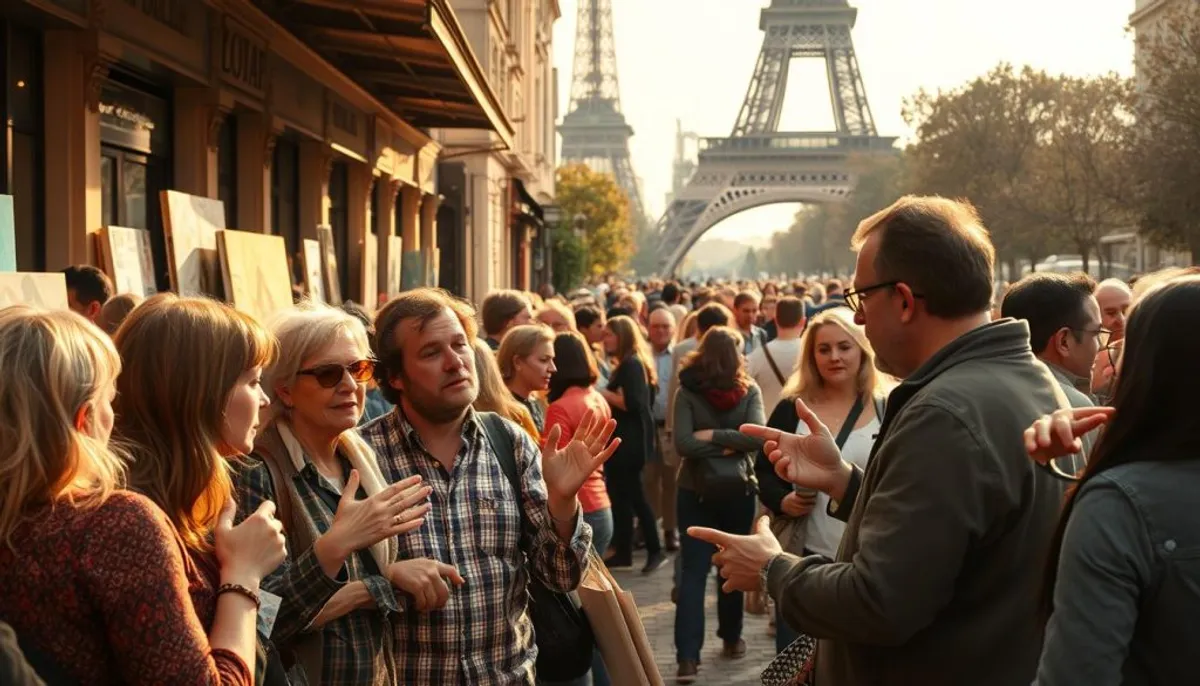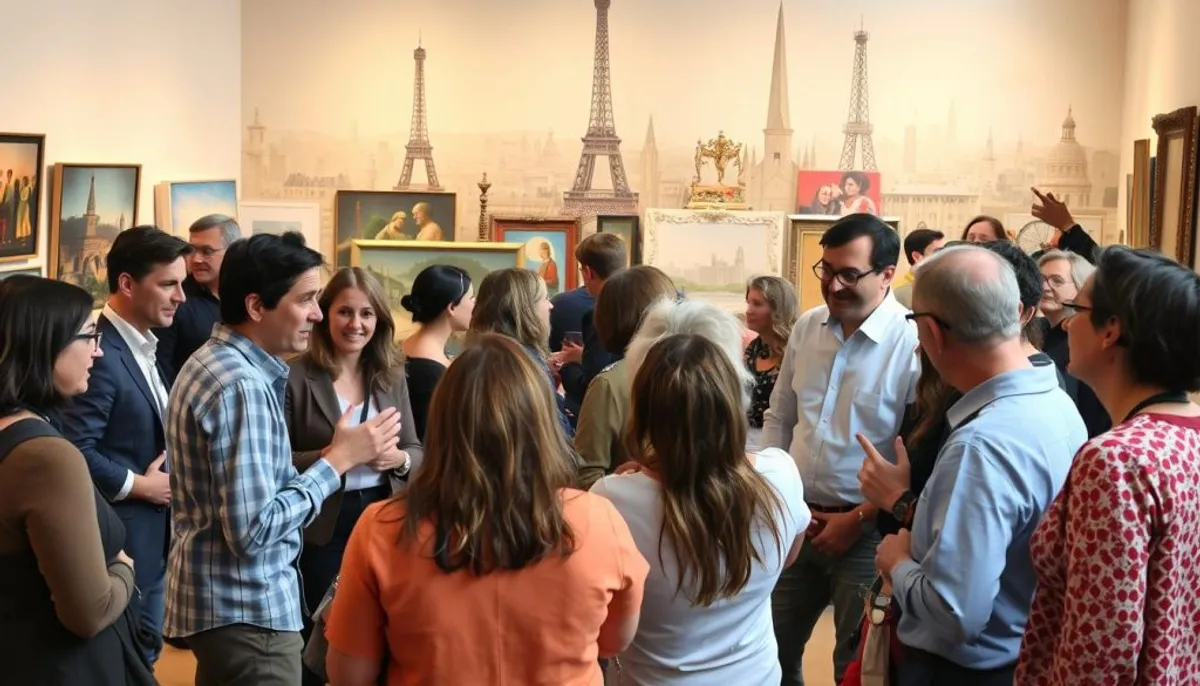The history of Belgian artists and their relationship with French culture is rich and complex. Since Belgium's independence in 1830, creators have navigated between influence and affirmation of their unique cultural identity.
Paris, the global artistic center at the beginning of the 20th century, exerted a powerful attraction on Belgian artists. The geographical and linguistic proximity fostered intense exchanges between the two countries.

The period from 1890 to 1910 was marked by tensions but did not provoke notable criticism from Belgian intellectuals towards France. On the contrary, French-speaking Belgian writers directed their critical gaze towards their own society.
The influence of French culture has amplified over the decades in various fields in Belgium. The Belgian French-speaking educational system has long emphasized the study of French authors, reinforcing this cultural link.
Today, Belgian artists continue to position themselves in relation to the French heritage. They seek to assert their unique voice while fitting into a broader Francophone cultural space.
What relationship with French culture characterizes Belgian artists
Belgian artists maintain a complex relationship with French culture. This cultural interaction finds its origin in a shared Francophone heritage. However, they retain a distinct identity. The cultural influence of France on Belgium manifests uniquely in the artistic world.
The historical influence of French culture
The geographical and linguistic proximity between Belgium and France has fostered intense cultural exchanges. France, after the Treaty of Versailles in 1919, became a central political force in Europe. This strengthened its cultural influence. This period profoundly marked Belgian artists, nourishing their creativity and inspiration, and also contributed to a true cultural convergence between the two nations.
The Francophone heritage is reflected in various artistic fields in Belgium. Belgian painting, literature, and music bear the imprint of this cultural influence from France. However, they also develop their own distinctive characteristics.
The status of the artist in Belgium and France illustrates the differences and similarities between these two countries:
| Aspect | Belgium | France |
|---|---|---|
| Coverage of status | All artistic fields | Mainly live and recorded arts |
| Unemployment benefits | Non-degressive for artists | Special regime for certain artists |
| Job precariousness | Systematic | Systematic |
| Periods of activity | Paid/unpaid alternation | Paid/unpaid alternation |
This comparison highlights the nuances in each country's approach to its artists. It reflects both the common Francophone heritage and the national particularities in supporting artistic creation.
The great Belgian masters in Paris
Paris, the cultural capital, attracts artists from Francophone Belgium. These artistic exchanges enrich the Francophonie and strengthen ties between the two countries. Three great Belgian masters have particularly marked the Parisian scene.
Magritte and surrealism at Beaubourg
René Magritte, an iconic figure of surrealism, captivated the Parisian public. His retrospective at the Centre Pompidou attracted over 500,000 visitors, demonstrating the enthusiasm for Belgian art in France. Magritte's enigmatic canvases sparked numerous debates on the unconscious and perception.
Hergé and comic books at the Grand Palais
The creator of Tintin, Hergé, was the subject of a major exhibition at the Grand Palais. This recognition of Belgian comic books as a legitimate art form strengthened the artistic exchanges between the two countries. The exhibition highlighted Hergé's influence on French popular culture.
Philippe Geluck and contemporary art
Philippe Geluck, with his philosophical Cat, has won the hearts of Parisians. His exhibition "Art and the Cat" at the Musée en herbe blended humor and reflection, appealing to both young and old. Geluck embodies the renewal of contemporary Belgian art in France.
| Artist | Exhibited works | Visitors | Cultural impact |
|---|---|---|---|
| Magritte | 100 | 500,000 | Surrealist revolution |
| Hergé | 250 | 300,000 | Recognition of comics |
| Geluck | 80 | 150,000 | Renewal of humor |

These exhibitions have strengthened cultural ties between France and Francophone Belgium. They have also contributed to the emergence of a new generation of Belgian artists on the Parisian scene, thus perpetuating the tradition of artistic exchanges between the two countries.
The new generation of Belgian artists in France
Belgian artists, with their limitless creativity, are making their mark on the French scene. Their influence extends to various fields, particularly in music. These artistic exchanges deeply enrich the Francophone cultural landscape.
Stromae and the musical revolution
Stromae, an icon of Belgian music, has revolutionized the French scene. His provocative lyrics and unique blend of electro and French song have captivated a wide audience. His album "Racine Carrée" sold over 2 million copies in France.
Angèle and Francophone pop
Angèle represents the new wave of Belgian pop. Her innovative style and engaged lyrics have charmed the French. Her debut album "Brol" was certified diamond in France, illustrating her meteoric success.
Damso and Belgian rap
Damso has popularized Belgian rap in France. His bold lyrics and unique flow have marked the genre. His albums consistently reach the top of the French charts, demonstrating the public's appeal for his distinctive style.
| Artist | Genre | Flagship album | Certifications in France |
|---|---|---|---|
| Stromae | Electro-pop | Racine Carrée | Diamond |
| Angèle | Pop | Brol | Diamond |
| Damso | Rap | Ipséité | Platinum |
These Belgian artists play a key role in the artistic exchanges between Belgium and France. Their success shows the openness of the French public to new musical influences. This strengthens the cultural ties between the two countries.
Diplomatic and cultural initiatives
France and Belgium have significantly strengthened their artistic ties over time. Diplomatic and cultural efforts have been essential in enhancing cultural interaction between these two Francophone nations.
In 1997, a major joint exhibition highlighted the impact of historical, economic, and sociocultural contexts on artistic exchanges from 1848 to 1914. This collaboration was a turning point in understanding Franco-Belgian artistic relations.

The interwar period saw the emergence of new dynamics. The creation of the French Association for Expansion and Artistic Exchanges (AFEEA) in 1922 marked the beginning of a structured cultural diplomacy. Funded at 50% by the Ministry of Foreign Affairs, AFEEA multiplied exhibitions of French art abroad.
The 1920s experienced a surge in artistic exchanges. Paris and London became favored hubs for international exhibitions. An exchange system was established, reinforcing cultural interaction between states.
| Period | Key initiative | Impact on Francophonie |
|---|---|---|
| 1922 | Creation of AFEEA | Structuring of cultural diplomacy |
| 1920s | Multiplication of exhibitions | Strengthening of artistic exchanges |
| 1997 | Joint France-Belgium exhibition | In-depth understanding of cultural ties |
These initiatives have allowed Belgian artists to gain visibility in France, enriching the Francophone cultural landscape. The fostered cultural interaction has contributed to the flourishing of a dynamic and diverse artistic scene.
The impact of Belgian artists on the French cultural scene
The cultural influence of Belgian artists in France is undeniable. Their unique cultural identity, stemming from Francophone Belgium, has significantly enriched the French artistic landscape.
In the visual arts
Belgian artists have made their mark on French visual arts, particularly through French art. Their distinctive style, often imbued with surrealism, has captivated the Parisian public. Major exhibitions in France's great museums have celebrated their talent and originality.
In music
The French music scene has been transformed by the arrival of Belgian artists. Their innovative approach and unique cultural identity have brought a fresh breath to Francophone pop and rap. These artists have managed to win over a wide audience, transcending national borders.
In live performance
Belgian theater has also left its mark in France. Companies like Les Compagnons de France have contributed to renewing theatrical traditions. In 1942, 47 "peasant" troupes were created, working closely with the Maison des Arts libéraux. These initiatives helped develop a dynamic local theater, with more than 23 groups of trained actors.
The impact of Belgian artists on the French cultural scene is profound and lasting. Their contributions have enriched and diversified the artistic landscape, offering new perspectives and forms of expression. This cultural influence testifies to the richness of exchanges between Francophone Belgium and France.
Conclusion
The relationship between French culture and Belgian artists has evolved over time. These exchanges have created a unique cultural landscape, where French influence and Belgian identity blend harmoniously. Figures like Magritte and Stromae illustrate the impact of Belgian artists on the French public.
The relationship between the two cultures is reflected in impressive statistics. In 1951, the exhibition "The Child and the Books" in Paris showcased works from 40 nations, symbolizing France's cultural openness. The founding of IBBY in 1953 strengthened international ties in children's literature, benefiting Belgian authors.
Today, Belgian artists continue to make their mark on the French cultural scene. With a Belgian population of 10.5 million, of which 95% are Francophone in Brussels, the opportunities for artistic exchanges are vast. The future promises even closer collaboration, enriched by the linguistic and cultural diversity of both nations.
RelatedRelated articles


